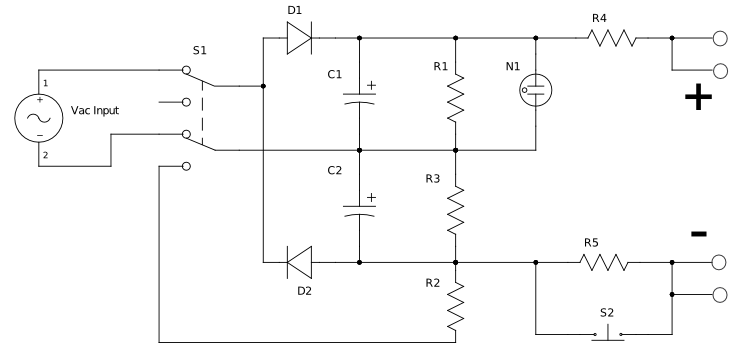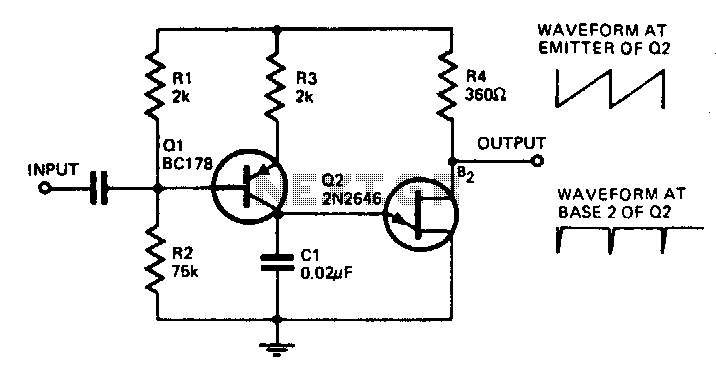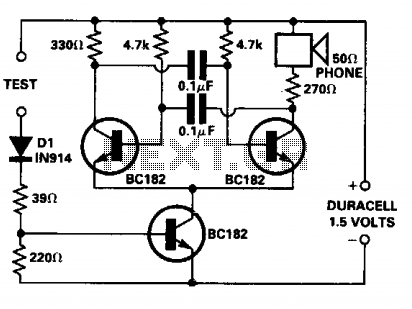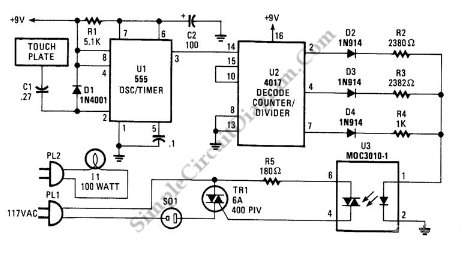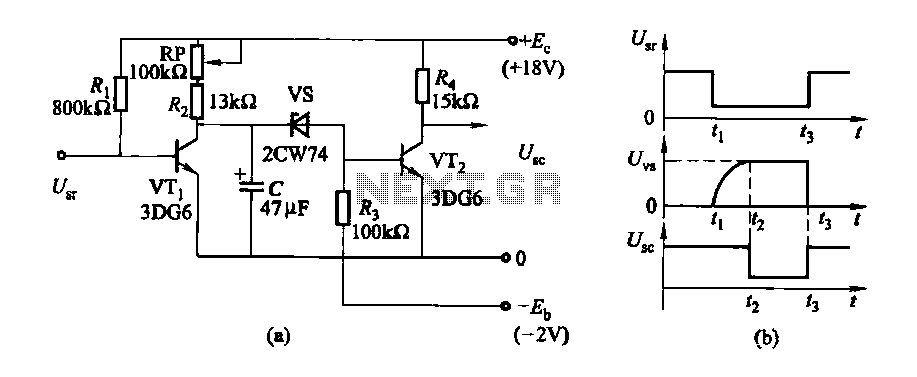
IR Remote Control Tester
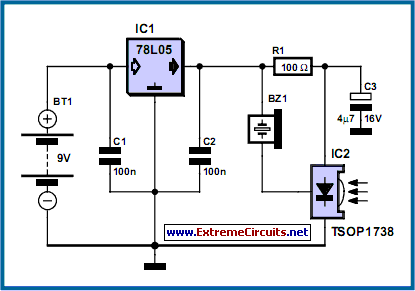
This small circuit is designed to verify the basic functionality of an infrared remote control unit. The circuit utilizes a straightforward approach by connecting a piezo buzzer directly to an IR receiver integrated circuit (IC). This configuration is as simple as connecting a photodiode directly to an oscilloscope, but it offers the advantage of not requiring an oscilloscope: the compact unit is always ready for use and is significantly more portable than bulky test equipment. The operation of the remote control is signified by the buzzer producing a chattering sound. The circuit exhibits high sensitivity and can operate over several meters. The TSOP1738 integrated IR receiver accepts, amplifies, and demodulates the IR signal from the remote control, generating an output with a frequency of approximately 700 Hz. The piezo buzzer is connected to this output, making the signal audible. The remaining components are focused on generating a stable 5 V power supply from a 9V PP3 (6F22) type battery. Alternative devices from other manufacturers can replace the TSOP1738, and carrier frequencies other than 38 kHz can also be utilized. Although the circuit continues to function with a mismatch between the nominal carrier frequencies of the transmitter and receiver IC, the range may be diminished. Nevertheless, it remains sufficient for determining whether a remote control is emitting an IR signal.
This circuit schematic consists of a few key components that facilitate its operation. The TSOP1738 IR receiver is the primary component, responsible for receiving the infrared signals emitted by the remote control. It operates at a carrier frequency of 38 kHz, which is standard for many remote control devices. The receiver amplifies and demodulates the incoming signal, outputting a square wave signal at approximately 700 Hz when it detects a valid IR signal.
The piezo buzzer, connected directly to the output of the TSOP1738, serves as the auditory indicator of the detected signal. When the IR receiver picks up a signal from the remote control, the buzzer produces a chattering noise, alerting the user to the remote's functionality.
Power supply stability is crucial for the reliable operation of the circuit. A 9V PP3 (6F22) battery is used to power the circuit, and a voltage regulator or a simple resistor divider can be implemented to ensure that a stable 5 V is provided to the TSOP1738 and the buzzer. This arrangement allows the circuit to operate efficiently without the need for complex power management.
The design is flexible, as it can accommodate different IR receiver ICs and can be adapted to work with varying carrier frequencies. However, it is important to note that while the circuit will still function with mismatched frequencies, the effective range may be reduced. This versatility makes the circuit suitable for testing a variety of remote control devices, confirming their operation through an audible output.This small circuit is ideal for checking the basic operation of an infrared remote control unit. The circuit is based on the brilliantly simple idea of connecting a piezo buzzer directly to an IR receiver IC. This method is almost as simple as connecting a photodiode directly to the input of an oscilloscope, but has the advantage that no oscillosc
ope is needed: the compact unit is always ready to use and much easier to carry around than bulky test equipment. Operation of the remote control is indicated by the buzzer making a chattering noise. The circuit is very sensitive and has a range of several meters. The TSOP1738 integrated IR receiver accepts, amplifies and demodulates the IR signal from the remote control, producing an output with a frequency of around 700 Hz.
The piezo buzzer is connected to its output, rendering the signal audible. All the other components are simply concerned with producing a stable 5 V power supply from the 9V PP3-(6F22) type battery. Instead of the TSOP1738 similar devices from other manufacturers can be used, and of course carrier frequencies other than 38 kHz can be used.
The circuit still works if there is a mismatch between the nominal carrier frequencies of the transmitter and receiver IC, but range is reduced. It is still, however, adequate for determining whether a remote control is producing an IR signal or not.
🔗 External reference
This circuit schematic consists of a few key components that facilitate its operation. The TSOP1738 IR receiver is the primary component, responsible for receiving the infrared signals emitted by the remote control. It operates at a carrier frequency of 38 kHz, which is standard for many remote control devices. The receiver amplifies and demodulates the incoming signal, outputting a square wave signal at approximately 700 Hz when it detects a valid IR signal.
The piezo buzzer, connected directly to the output of the TSOP1738, serves as the auditory indicator of the detected signal. When the IR receiver picks up a signal from the remote control, the buzzer produces a chattering noise, alerting the user to the remote's functionality.
Power supply stability is crucial for the reliable operation of the circuit. A 9V PP3 (6F22) battery is used to power the circuit, and a voltage regulator or a simple resistor divider can be implemented to ensure that a stable 5 V is provided to the TSOP1738 and the buzzer. This arrangement allows the circuit to operate efficiently without the need for complex power management.
The design is flexible, as it can accommodate different IR receiver ICs and can be adapted to work with varying carrier frequencies. However, it is important to note that while the circuit will still function with mismatched frequencies, the effective range may be reduced. This versatility makes the circuit suitable for testing a variety of remote control devices, confirming their operation through an audible output.This small circuit is ideal for checking the basic operation of an infrared remote control unit. The circuit is based on the brilliantly simple idea of connecting a piezo buzzer directly to an IR receiver IC. This method is almost as simple as connecting a photodiode directly to the input of an oscilloscope, but has the advantage that no oscillosc
ope is needed: the compact unit is always ready to use and much easier to carry around than bulky test equipment. Operation of the remote control is indicated by the buzzer making a chattering noise. The circuit is very sensitive and has a range of several meters. The TSOP1738 integrated IR receiver accepts, amplifies and demodulates the IR signal from the remote control, producing an output with a frequency of around 700 Hz.
The piezo buzzer is connected to its output, rendering the signal audible. All the other components are simply concerned with producing a stable 5 V power supply from the 9V PP3-(6F22) type battery. Instead of the TSOP1738 similar devices from other manufacturers can be used, and of course carrier frequencies other than 38 kHz can be used.
The circuit still works if there is a mismatch between the nominal carrier frequencies of the transmitter and receiver IC, but range is reduced. It is still, however, adequate for determining whether a remote control is producing an IR signal or not.
🔗 External reference
